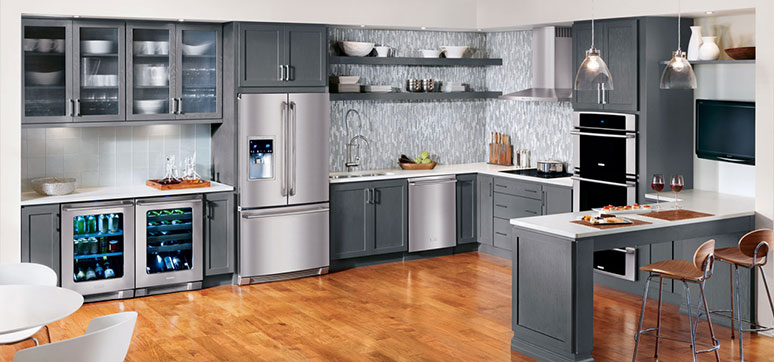The modern home is a blend of style, functionality, and cutting-edge technology. At the heart of this transformation lies the evolution of kitchen and bathroom worktops, which are not only central to the aesthetics of a space but also its utility. Over the years, the materials used for worktops have seen a significant evolution. From the elegance of quartz worktops to the durability of Corian worktops, and the modern appeal of Hi-Macs worktops, homeowners and designers have a plethora of choices. Each material brings its unique charm, benefits, and maintenance requirements, making the selection of worktops a crucial aspect of interior design.
As the digital era continues to influence various facets of our lives, the integration of technology into worktop design is a natural progression. This fusion is not merely about adding a modern touch but enhancing the functionality, safety, and efficiency of kitchen and bathroom spaces. Smart worktops, equipped with charging ports, built-in tablets for recipe browsing, or even integrated weighing scales, are transforming everyday tasks into a seamless experience.
The advancements in worktop technology also usher in a new phase for worktop installation. Installers now find themselves navigating not just the physical aspects of the installation but also the digital elements. The collaboration between worktop suppliers and installers is becoming more intertwined, with a shared goal of delivering a product that meets the modern homeowner’s desires for a smart, functional, and aesthetically pleasing space.
This burgeoning trend of technology integration within worktops and the installation process heralds an exciting era of innovation in the home improvement industry, bringing about a blend of tradition and modernity that is set to redefine our domestic spaces.
The Intersection of Materials and Technology
The world of worktop materials is a rich and diverse one, offering a range of options to cater to different tastes, needs, and budget considerations. Among the popular choices are Corian worktops, known for their durability and versatility, quartz worktops, prized for their elegance and low maintenance, and Hi-Macs worktops, which are gaining traction for their modern appeal and robustness. Each of these materials has its unique set of advantages, and the choice often comes down to personal preference and the specific needs of a space.
Technological Advancements in Corian Worktops
Corian, a solid surface material known for its durability and ease of maintenance, now offers possibilities for tech-enhanced upgrades. Homeowners have the option to customise their Corian worktops with additions like integrated wireless charging spots, allowing for a clutter-free charging solution for smart devices. Additionally, the non-porous nature of Corian makes it an excellent choice for those looking to integrate smart hygiene features like touchless soap dispensers or faucet sensors, contributing to a cleaner and more hygienic
kitchen or bathroom environment.
The Smart Features of Quartz Worktops
Quartz, a naturally beautiful and incredibly durable material, is also embracing the tech wave. Some quartz worktops now come with built-in LED lighting, enhancing the aesthetics and functionality of the space. The lights can be controlled via smart home systems, enabling homeowners to adjust the ambiance according to their mood or the time of day. Additionally, the hardness and non-porous nature of quartz make it an ideal candidate for integrating smart hygiene solutions, similar to Corian.
Innovations in Hi-Macs Worktops
Hi-Macs, an acrylic solid surface material, is following suit with its tech-friendly features. Modern Hi-Macs worktops can be customised with integrated digital touch controls for smart home systems or appliances, offering a sleek and modern look while keeping the functionality at the fingertips of the homeowner. The seamless design of Hi-Macs worktops makes it easier to incorporate tech features in a visually appealing and functional manner.
The integration of technology into these traditional worktop materials is not just about staying current with the latest trends. It’s about enhancing the functionality, safety, and user experience of the spaces we inhabit daily. As we continue to see the fusion of the digital and physical worlds, the realm of worktop materials is undoubtedly an exciting space to watch.
Worktop Installation in the Digital Age
The advancement in technology not only enhances the functionality and aesthetic appeal of worktops but also significantly impacts the worktop installation process. As worktop materials evolve to include tech-integrated features, the installation process too, must adapt to ensure seamless integration and functionality.
Modern Installation Techniques
The installation of tech-integrated worktops requires a blend of traditional craftsmanship and modern technical know-how. Installers now need to consider not just the physical installation of the worktop, but also the integration of technological features such as wireless charging spots, touch controls, or built-in lighting systems. This calls for a well-coordinated approach between the worktop supplier, the installer, and possibly even electricians or smart home integrators to ensure all features function as intended post-installation.
Training and Expertise Required for Installers
The modern-day installer needs to be well-versed not only in the traditional aspects of worktop installation but also in the technological facets. Training on electrical safety, understanding of smart home systems, and coordination with other tech integrators become crucial. The goal is to ensure that the worktop not only fits well and looks good but also functions seamlessly with the integrated tech features.
Tools of the Trade: Emerging Tech in Installation
Even the tools and techniques used in the installation process are evolving with technology. Laser templating for precise measurements, digital rendering software for visualising the final look, and smart tools for ensuring perfect levelling and alignment are becoming the norm. These tech tools help in reducing errors, saving time, and ensuring a high level of precision in the worktop installation process.
The digital transformation in the worktop industry extends beyond the surface, impacting the way worktops are installed and how installers interact with these modern surfaces. As tech-integrated worktops become more commonplace, embracing the new tools and techniques is crucial for installers to deliver a well-integrated, functional, and aesthetically pleasing worktop space to the modern homeowner.
Smart Worktop Accessories
In addition to the tech-integrated worktops, modern kitchen and bathroom spaces are being enhanced by smart accessories that further augment the user experience.
The Convenience of Smart Taps
Smart taps, including boiling water taps like Quooker, offer instant access to hot, cold, and even boiling water, simplifying tasks and saving time. They also come with safety features to prevent accidental scalding, making them a practical addition to modern homes.
Integrating Tech-Enabled Accessories for a Functional Workspace
Other tech-enabled accessories like digital scales integrated into the worktop or smart compost bins help in making the kitchen workspace more functional and efficient, embodying the modern-day ethos of a smart home.
The Benefits of Tech-Integrated Worktops
The integration of technology into worktops and the accompanying accessories brings about numerous benefits that go beyond mere aesthetic appeal.
Enhanced Functionality and Efficiency
Tech-integrated worktops streamline daily tasks, making kitchen and bathroom spaces more user-friendly and efficient.
Creating a Safer Kitchen and Bathroom Environment
Technological features like touchless faucets or smart lighting enhance safety, by reducing the spread of germs or providing better illumination.
Conclusion
The fusion of technology with traditional worktop materials and installation processes is a testament to the evolving landscape of home improvement. As worktop installation evolves to accommodate tech-integrated surfaces and accessories, it paves the way for more functional, efficient, and aesthetically pleasing kitchen and bathroom spaces. This intersection of tradition and innovation not only enhances the daily living experience but also signifies the exciting future of the worktop industry in the digital age.








